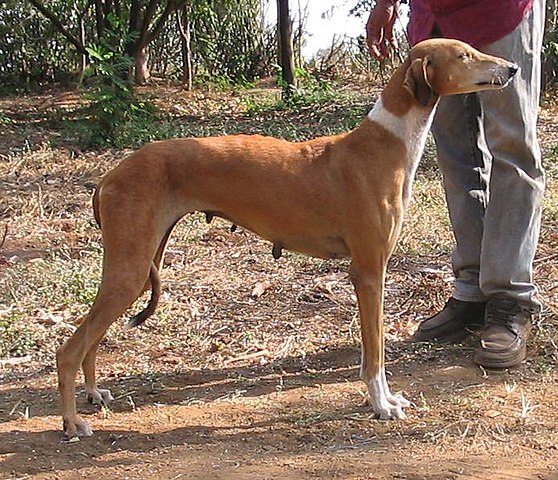Although he is occasionally considered to be the same breed as the Mudhol Hound, the Kennel Club of India recognizes the Caravan Hound as a separate and distinct breed. This is an ancient breed which is a close relative to the Saluki. The breed’s ancestors were brought to India from Asian traders who traveled in caravans – hence the name. The Caravan is loyal although has an independent personality as his primary purpose had been to hunt autonomously from people, as well as guard the homestead. He is aloof and reserved in temperament.
It is important to socialize a Caravan from a young age as he is naturally protective and territorial. Although most do not enjoy being handled by strangers, early socialization to stranger contact is essential since all dogs must learn to tolerate a vet exam. Without this important step, he can become either extremely fearful or aggressive. This sensitive breed does best with gentle owners who don’t live in chaotic households. Apartments – frequently teeming with tenants – can also be a bit much for this sensitive, yet protective hound. He does much better in a quiet home with a large fenced yard for him to run in.
The Caravan Hound prefers warm climates although can make due in cold weather as long as he is provided a coat. In warm climates he enjoys spending time outside to stretch his legs, although should be given plenty of indoor time so he can relax with his owners. Although independent, he’s not the best match for people that work all day and would be leaving the dog home alone for long bouts of time.
Caravans require extensive exercise every day, and this should be given in a fenced area or on-leash. Like most sighthounds he has a very high prey instinct and will not heed his owners call if in pursuit of a rabbit or similar animal! He should be provided not only with regular long walks, but also routine periods for off-leash running in a securely fenced area. His large size requires a large yard (or fenced space) in order to get up to full speed and thus get the exercise he needs. He is recommended only for active people, and ideally those who are experienced with sighthounds.
The Caravan Hound is trainable but can prove difficult for a novice unfamiliar with sighthound temperament. He is strong-willed and can be harder to motivate than other dogs. He also doesn’t fare well with harsh treatment or training and this must be kept in mind when working with him. Finally, while he is highly intelligent – he may not always jump to follow commands quickly.
Caravans are generally quiet and gentle, and can be great family dogs in the right setting. While most are playful and loving with kids, it’s best if children are older and well-behaved as this breed doesn’t tolerate rude behavior. Because of their general distrust of strangers, they do best in peaceful homes without frequent parties or gatherings. Finally, many can’t be trusted around cats. So while they can be family dogs, a number of circumstances must be met in order to ensure a good match for this breed. This is a hunting breed that doubled as a watchdog or even guard dog in India, which means he is more serious than the typical laid-back companion-bred types sought out by most families.
The head of the Caravan Hound should be long and narrow, with hanging ears set on above the level of the eyes. When it comes to grooming, this is one of the most low-maintenance breeds there is. A quick brush down once a week is enough to keep the coat in check. The coat itself is one of the breed’s distinguishing features, and should be extremely short and “unique”. The breed sheds an average amount. Colors include black, seal, red, gray, fawn, cream, or black and tan. Minimal white markings, sable shading, and black masks are allowed.

Photo by CC BY-SA 3.0
